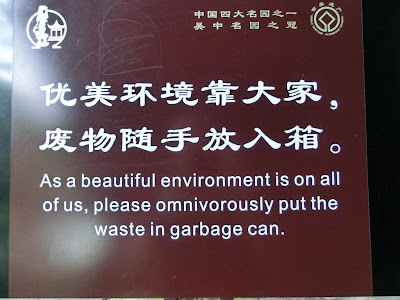The boats must come and go past these houses at least one hundred times each day. It appears the the residents have gotten used to the noise and the gawkers because you can see them going about their lives as if no one is there. The top photo shows a lady going out to the canal. She has something in her hand, though I'm not able to make out exactly what it is. She is intent on some type of housework.
The gentleman above is checking out his garden. The fellow below is drawing water from the canal. You can see he's lowered a bucket on a rope. He pulled up three bucketfuls during the time we passed by. I'd like to think he is watering plants....but he may be using the water to wash his clothes or his dishes. I can't believe he is using this water to cook with, but I wouldn't rule that out.
It seems these folks are living here on the canals as people have done for hundreds of years. They use the water as probably people here have always used it. I would guess the water quality has improved over the past 50 years. It certainly doesn't stink...at least not like the waters of Venice stink of fish and seawater. But I still would not think the water qualifies as clean. Though the canal is not clogged with trash, Joe and I saw bottles and papers floating by and even an old pair of shoes. Keep in mind, too, that Suzhou's taxi drivers think the world is their urinal.
For the people here, it is clean enough to wash clothes. The folks above are not the only ones we saw doing their laundry on this Saturday morning. There were others. The lady on the right was washing as we went up to Tiger Hill and was still at it when we returned about two hours later. That's at least two hours stooped over in the hot sun and humidity flailing at dirty undies and such. It makes me appreciate our washing machine.
By the way, in most stores you can find washboards for sale. They are usually on the shelves beside the detergent. That suggests that a lot of people are still doing laundry by hand. They may not all be laundering with canal water. But still, it's a far cry from what we're used to back home.
The water not only giveth, but it also taketh away. The fellow above is peeling his potatoes into the canal. It's the ultimate in garbage disposals. Perhaps his potato peels provide the starch for the people laundering downstream.
 It's not just on the back porch that you see the people. You also see them through the windows opened to bring the breeze into the house. If you look closely at the photo above, at the window at left, you can see a shirtless man working in his kitchen. A closer look makes me think he is in his boxer shorts. On the window is his bucket to draw the waters from the canal.
It's not just on the back porch that you see the people. You also see them through the windows opened to bring the breeze into the house. If you look closely at the photo above, at the window at left, you can see a shirtless man working in his kitchen. A closer look makes me think he is in his boxer shorts. On the window is his bucket to draw the waters from the canal.This is a way of living that I've never seen before. I don't know if they live like this because of habit or tradition. I don't know if they live like this because they're too poor to live otherwise. Maybe it's all of the above. I just don't know. From what I can tell, the vast majority of people in Suzhou live in houses with running water and electricity and normal modern conveniences. China is not the Pearl S. Buck novel picture of poverty that it used to be. But it is a place of curious contradictions. Or as the King of Siam would say to Anna....It's a puzzlement.


















































